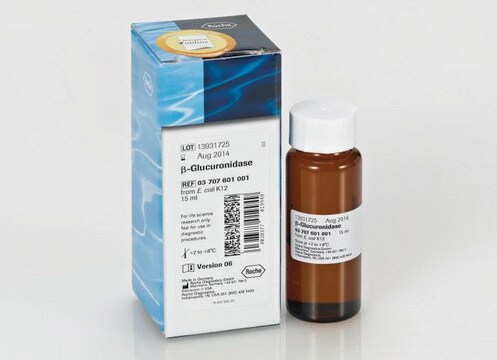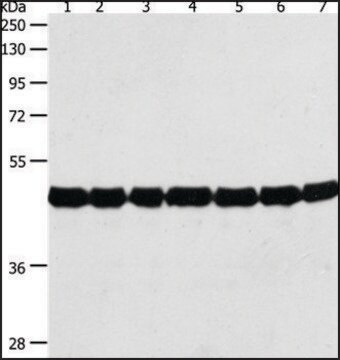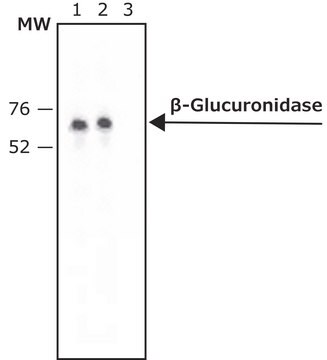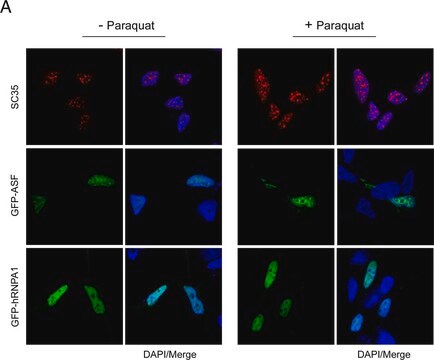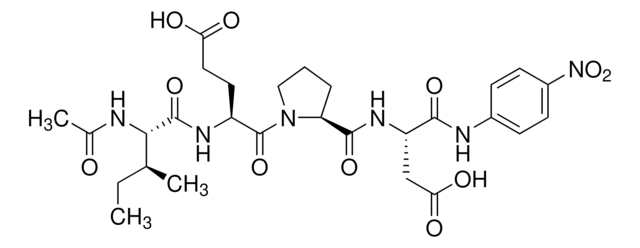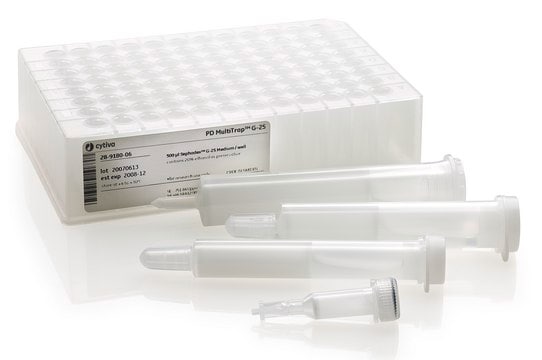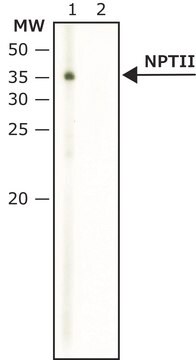G5545
Anti-β-Glucuronidase (C-Terminal) antibody produced in rabbit
~1.5 mg/mL, affinity isolated antibody, buffered aqueous solution
Sinônimo(s):
Anti-GUS
Faça loginpara ver os preços organizacionais e de contrato
About This Item
conjugado:
unconjugated
application:
WB
clone:
polyclonal
reatividade de espécies:
plant
citations:
5
técnica(s):
western blot: 1-2 μg/mL using purified GUS from E. coli
Produtos recomendados
fonte biológica
rabbit
Nível de qualidade
conjugado
unconjugated
forma do anticorpo
affinity isolated antibody
tipo de produto de anticorpo
primary antibodies
clone
polyclonal
Formulário
buffered aqueous solution
peso molecular
antigen 60 kDa
reatividade de espécies
plant
concentração
~1.5 mg/mL
técnica(s)
western blot: 1-2 μg/mL using purified GUS from E. coli
Condições de expedição
dry ice
temperatura de armazenamento
−20°C
modificação pós-traducional do alvo
unmodified
Descrição geral
β-Glucuronidase (GUS) gene (also referred to as uidA) from Escherichia- coli, codes for a 60kDa protein.
Especificidade
Anit-β-Glucuronidase (C-Terminal) recognizes bacterial GUS expressed in transgenic tobacco plants.
The antibody recognizes bacterial GUS expressed in transgenic tobacco plants.
Imunogênio
synthetic peptide corresponding to amino acids 589-603 at the C-terminus of E. coli GUS, conjugated to KLH.
Aplicação
Detection of GUS by immunoblotting (60 kDa). Staining of the GUS band in immunoblotting is specifically inhibited by the immunizing GUS peptide (E. coli, amino acids 589-603).
Ações bioquímicas/fisiológicas
β-Glucuronidase (GUS) acts as a reporter gene for plant studies. Reporter genes are widely used for studying the expression of foreign genes in transformed plant tissues. GUS is an hydrolase that catalyzes the cleavage of a variety of β-glucuronide derivatives available for colorimetric, fluorometric and histochemical assays. GUS activity is easily assayed in vitro and can withstand fixation, enabling histochemical localization in cells and tissue sections. However, one of the major limitations of the gus reporter gene system is that the histochemical GUS assay system is destructive for the plant tissue, and therefore it is not suitable for direct visual selection of transformed plants.
forma física
Solution in 0.01 M phosphate buffered saline, pH 7.4, containing 15 mM sodium azide.
Nota de preparo
The antibody is affinity-purified using the immunizing peptide immobilized on agarose.
Exoneração de responsabilidade
Unless otherwise stated in our catalog or other company documentation accompanying the product(s), our products are intended for research use only and are not to be used for any other purpose, which includes but is not limited to, unauthorized commercial uses, in vitro diagnostic uses, ex vivo or in vivo therapeutic uses or any type of consumption or application to humans or animals.
Não está encontrando o produto certo?
Experimente o nosso Ferramenta de seleção de produtos.
produto relacionado
Código de classe de armazenamento
10 - Combustible liquids
Classe de risco de água (WGK)
WGK 3
Ponto de fulgor (°F)
Not applicable
Ponto de fulgor (°C)
Not applicable
Escolha uma das versões mais recentes:
Já possui este produto?
Encontre a documentação dos produtos que você adquiriu recentemente na biblioteca de documentos.
Benjamin Dugdale et al.
The Plant cell, 25(7), 2429-2443 (2013-07-11)
In this study, we describe a novel protein production platform that provides both activation and amplification of transgene expression in planta. The In Plant Activation (INPACT) system is based on the replication machinery of tobacco yellow dwarf mastrevirus (TYDV) and
Mark D Harrison et al.
Plant biotechnology journal, 9(8), 884-896 (2011-03-02)
A major strategic goal in making ethanol from lignocellulosic biomass a cost-competitive liquid transport fuel is to reduce the cost of production of cellulolytic enzymes that hydrolyse lignocellulosic substrates to fermentable sugars. Current production systems for these enzymes, namely microbes
Sebastian N W Hoernstein et al.
Molecular & cellular proteomics : MCP, 15(6), 1808-1822 (2016-04-14)
Protein arginylation is a posttranslational modification of both N-terminal amino acids of proteins and sidechain carboxylates and can be crucial for viability and physiology in higher eukaryotes. The lack of arginylation causes severe developmental defects in moss, affects the low
Biolistic-mediated genetic transformation of cowpea (Vigna unguiculata) and stable Mendelian inheritance of transgenes
Ivo Nayche L, et al.
Plant Cell Reports, 27(9), 1475-1483 (2008)
Transgenic Plants: Gene Constructs, Vector and Transformation Method
New Visions in Plant Science (2018)
Nossa equipe de cientistas tem experiência em todas as áreas de pesquisa, incluindo Life Sciences, ciência de materiais, síntese química, cromatografia, química analítica e muitas outras.
Entre em contato com a assistência técnica